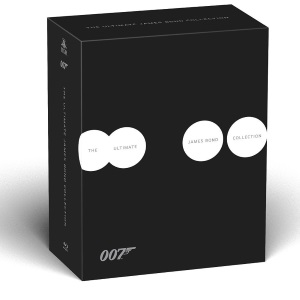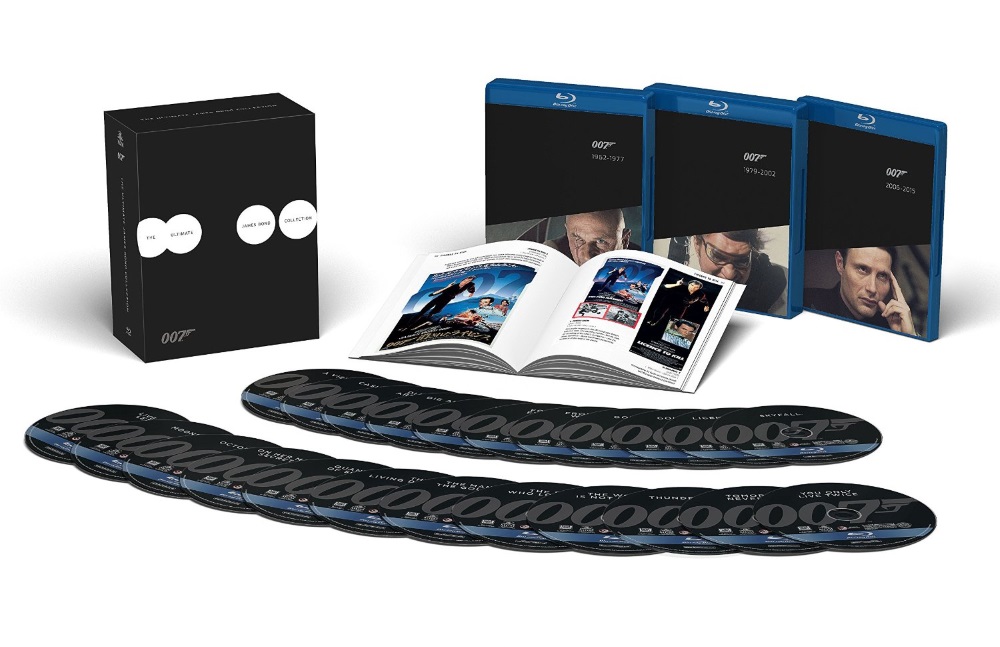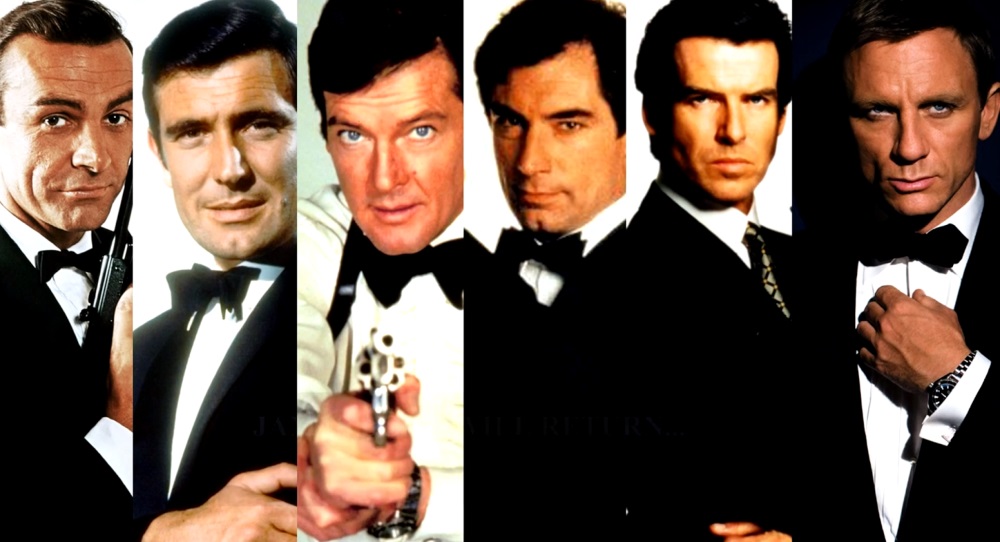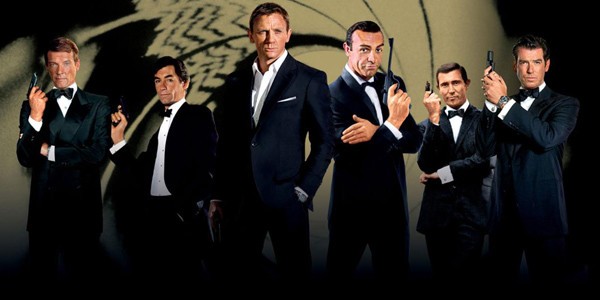 The Ultimate James Bond Collection (Fox, Blu-ray)
The Ultimate James Bond Collection (Fox, Blu-ray)
The release of every new Bond film seems to invite yet another repackaging of the official 007 series. In 2012, the entire run was finally collected and released on Blu-ray for the first time. Now, with Spectre due in theaters at the end of 2015, all 23 official films from Dr. No (1962) to Skyfall (2012) are packaged up in a much more compact box set than the previous bookleaf edition. This is only the second release of the complete series in a single volume, so
Each disc features a copy of the film (see below for thumbnail reviews) with flashy Maurice Binder-esque menu designs, rich commentaries which range from traditional give-and-take running observations to veritable audio documentaries, and a wide range of original featurettes, archival footage, and interactive supplements. There’s even a placeholder for Spectre right next to the bonus disc.
New to this collection is the 90-minute documentary Everything or Nothing: The Untold Story of 007, a well-made 2012 production (originally broadcast on TV) that surveys the series from the creative and production end, from Fleming’s novels through the entire run of films and all of the reinventions with every new Bond actor. Director Stevan Riley makes great use of unprecedented access to the families of Fleming and producers Albert “Cubby” Broccoli and Harry Salzman and features new interviews with Bond actors George Lazenby, Roger Moore, Timothy Dalton, Pierce Brosnan, and Daniel Craig (Connery is, no surprise, heard only in archival clips) and many other collaborators. It gets into the legal battles with Kevin McClory (who sued for the rights to make, and then remake, Thunderball), the fights with Sean Connery, the effect of UA’s financial troubles on the series, and other details that might seem a little insider-ish but actually shed light on the way Bond films got made over the years. An excellent addition to the Bondverse.
Less essential are two featurettes: “The Story So Far” (10 minutes) is basically a ten-minute illustrated recap of the Daniel Craig Bond films narrated by the screenwriters Neal Purvis and Robert Wade, who also narrate “The Shadow of Spectre” (8 minutes), a history of SPECTRE in the early Bond movies. There’s nothing much for either of them.
Carried over from the previous set is a collection of mostly brief original featurettes: “Being Bond,” a mere three-minute featurette with brief interview clips of each of the six actors discussing their approach to Bond (all from archival interviews); “Designing 007: 50 Years of Bond Style,” a four-minute survey of a museum exhibition of costumes, sketches, models, props, and other production artifacts from forty years of Bond movies; and “World of Bond” with six segments, all of them essentially clip montages. “Gadgets” and “Villains” run under three minutes each and “Bond Girls,” “Locations,” and “Bond in Motion” each run under two minutes. “Title Sequences” is the longest by far: every single opening credits sequence, one after another, which you can view straight through or pick your film. It runs over an hour. The Skyfall video blogs of the earlier release, which were pretty much just promotional videos, are not included and not missed.
The discs are collected in three wide bookleaf cases in a box set and fit easily next to standard Blu-ray discs on the shelf. Also included in the box is a booklet featuring poster art from each film (excerpted from a much more substantial full-sized volume).
Also available on DVD.

Sean Connery gave birth to the cinema’s most cruelly charismatic cold warrior in Dr. No (1962), Bond’s first big screen appearance. It’s lean and hard edged, far from the glitzy, gadget laden sequels, but it establishes one 007 standard when Ursula Andress, the original Bond girl, makes her entrance rising from the Mediterranean sea in a bikini. From Russia With Love (1963), 007’s second and perhaps finest outing, features a blonde, buff Robert Shaw as Bond’s most ruthless nemesis. Lotte Lenya and Pedro Armindariz co-star in this sleek, high energy trip through the Iron Curtain, which concludes with a non-stop chase across Europe. Goldfinger (1964) was the first blockbuster hit of the series and it solidified the Bond formula: groaning wit, Q’s glorious gadgets, a megalomaniac supervillain bent on world domination, and of course girls, girls, girls. Connery is as suave as ever, and the villain is dastardly indeed: “Do you expect me talk?” “No Mr. Bond, I expect you to die!” Thunderball (1965) was the biggest (and longest) film in the franchise to that time and climaxes with an elaborate underwater battle that still impresses. The gadgets almost take over in this Nassau based tale of stolen atomic weapons but Connery, more charming and ruthless than ever, commands. SPECTRE rears its conspiratorial head for the first time and Connery’s Bond travels to the Far East to take on its cat loving mastermind Blofeld (Donald Pleasance) in You Only Live Twice (1967). Love that underground headquarters in an active volcano!
Handsome, self-effacing Australian model George Lazenby made his only 007 appearance in the underrated On Her Majesty’s Secret Service (1969). It features great ski chases, a wild, careening car chase on icy roads, and the only time Bond married the babe (Diana Rigg – who could blame him?). After a brief retirement, Connery returned for his final appearance in the “official” Bond series with Diamonds Are Forever (1971), a tongue-in-cheek adventure in Las Vegas where he battles Blofeld (this time played by Charles Gray), a pair of fey, sardonic henchmen, and bikini-clad karate killers named Bambi and Thumper.
Roger Moore, famed for playing The Saint on TV and already aging past his romantic prime, inherited the Bond mantle from Connery (after the interim appearance of one trick 007 George Lazenby) with style in Live and Let Die (1973), a Caribbean adventure of voodoo and drug smuggling. Jane Seymour is heavenly as the fortune telling Domino. His second appearance in The Man With The Golden Gun (1974) pits him against master marksman and million dollar assassin Christopher Lee, one of Bond’s most charismatic villains, and his memorable sidekick Herve Villachez. It gets a little goofy but watch for the great corkscrew car jump.
The Spy Who Loved Me (1977) is one of Roger Moore’s best outings finds the suave but deadly agent in a post-cold war adventure with magnificent sets. Bond initiates détente with the exotic Russian agent Barbara Bach, but it’s still best remembered as the debut of Richard Kiel’s Jaws, who returns in Moonraker (1979), a “Star Wars”-inspired outer space adventure, but this goofy, misguided sci-fi extravaganza uses him as comic relief. Gorgeous effects can’t overcome a bland set of heroes and villains. In For Your Eyes Only (1981), Topol plays Bond’s most charming ally, a gregarious smuggler, and Roger Moore leaves the tongue-in-cheek silliness behind for a slim but lavish action packed globe-trotting adventure. The colorful cold war thriller Octopussy (1983) was one of Moore’s better Bond outings. Louis Jordan is a corrupt Afghan prince and Maud Adams (making her second Bond appearance) is the ringmaster of an all-babe traveling circus that unknowingly carries a nuclear bomb. Christopher Walken hams it up under a platinum blonde hairdo while his Amazon bodyguard Grace Jones growls through A View to a Kill (1985), a silly but often visually impressive adventure. Moore was too old and stiff to carry on the Bond legacy and Tanya Roberts is a lifeless Bond babe.
Timothy Dalton made his 007 debut in the lean, mean mode of Sean Connery in The Living Daylights (1987), doing away with the jokey camp of Roger Moore’s final outtings. It misses the larger than life characters and spectacle of previous Bond pictures, but it’s a sleek script with a no-nonsense attitude and Dalton made a tough, ruthless 007: a worthy inheritor of the legacy. He followed up with Licence to Kill (1989), another disappointment. Dalton got a bad rap as the series returned to the tough, lean action style of the first Bond films, eschewing gadgetry and glamour for grit, but the problem was in the scripts, not in Dalton.
Pierce Brosnan resurrected the franchise after six years as the new Bond in GoldenEye (1995). His debut is the best Bond film in years, combining the grit and cool of Connery with the romance and humor of Moore in an international caper that takes him from Siberia to Jamaica. Famke Jansen is the most deliciously untamed villain in decades. Tomorrow Never Dies (1997) is neither as fun or clever as Brosnan’s debut but it’s nice to see a Bond babe (Hong Kong action star Michelle Yeoh) hold her own against the suave super-agent and Jonathan Pryce is fun an old-fashioned super-villain with global aspirations. The World Is Not Enough (1999) is a bit silly (Denise Richards as a physicist named Christmas Jones?), but Sophie Marceau glows with feral glee as nemesis. And the series celebrated its 40th Anniversary with Die Another Day (2002), the 20th Bond feature, and the fourth and final go round for Brosnan, who crosses paths with slinky CIA spy Halle Berry (she rises from the surf like Ursula Andress in Dr. No) and fights his way through some of the most outrageous set pieces the series ever delivered.
Daniel Craig steps into the tuxedo of the world’s most famous spy in Casino Royale (2006), the back-to-the-basics thriller that refreshes the series by returning to Ian Fleming’s first Bond novel (previously made as a telefilm and a big-budget movie comedy) and charting the career of a still rough-around-the-edges British agent as he’s elevated to “00” status: the legendary “license to kill.” Martin Campbell, who also christened Pierce Brosnan’s debut in Goldeneye, returns as director. Quantum of Solace (2008) picks up right where to Casino Royale left off, with Bond on a mission of revenge and his rogue investigation takes him to the heart of the mysterious “Quantum” organization (the 21st century answer to SPECTRE?) and a conspiracy to hijack the world’s natural resources, but it’s the weakest of Craig’s Bond films and Mathieu Amalric, though one of the great actors in the world, is underwhelming as a Bond villain. Oscar-winning filmmaker Sam Mendes takes over for Skyfall (2012) and mixes up the gritty, scuffed-knuckle action of Casino Royale with great set-pieces, an appropriately maniacal villain (Javier Bardem), and a Bond backstory. Craig’s tough, roughed-up Bond has as much working class sand as high society style, a little too cold-blooded this time out (even Connery showed a little pang of responsibility when one of this lovers died on the course of an assignment), and stripping the film of gadgets for the bare-knuckle and booby-trap finale works very nicely. And don’t forget a great Bond theme song by Adele, a flashback to the great sixties bluesy-brassy themes, and the credits sequence, a necessary ritual in every cinematic offering.
Calendar of upcoming releases on Blu-ray, DVD, Digital, and VOD


